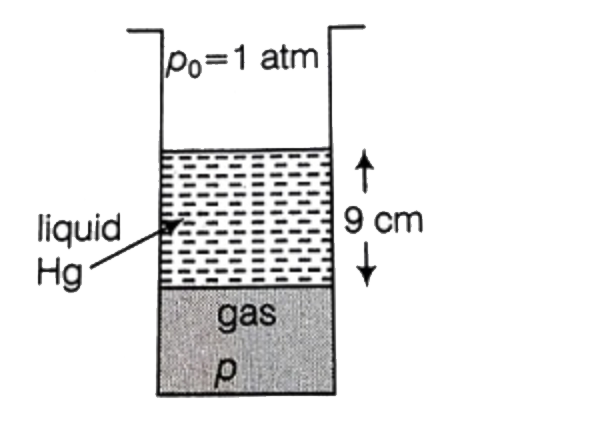Two tubes P and Q of lengths 100 cm and 30 cm have radii 0.1 mm and 0.2 mm, respectively. A liquid passing through the two tubes is entering P at a pressure of 60 cm of mercury-and leaving Q at a pressure of 55 cm of mercury. What is the pressure at the junction of Pand Q?
Given,
Tube P, Tube Q
Length _(l)=100cm lQ=30cm
Radius, rp=0.1mm=0.01cm,rQ=0.2mm=0.02cm
Pressure at which liquid enters P,PA=60 cm of Hg
Pressure at which liquid leaves Q,PQ=55 cm of Hg
Let Pj be the pressure at the junction of P and Q Rate of flow of liquid through tube P Qp=π(PP−Pj)r4P8ηlP
=π(60−Pj)(0.01)48η×100cm3s−1
Rate of flow of liquid through tube Q, QQ=π(Pj−PQ)r4Q8ηlQ
=π(Pj−55)(0.02)48η×30cm3s−1
Since Qp=QQ
therforeπ(60−Pj)(0.01)48η×100=π(Pj−55)(0.02)48η×30
⇒3(60−Pj)×(0.01)4=10(Pj−55)×(0.02)4
⇒3(60−Pj)=160(Pj−55)
⇒180−3Pj=160Pj−8800
⇒180+8800=163Pj
⇒Pj=8980163=55.09 cm of Hg
Topper's Solved these Questions
- MECHANICAL PROPERTIES OF FLUIDSBOOK - MODERN PUBLICATIONCHAPTER - MECHANICAL PROPERTIES OF FLUIDSEXERCISE - Practice Problems
52 Videos
- MECHANICAL PROPERTIES OF FLUIDSBOOK - MODERN PUBLICATIONCHAPTER - MECHANICAL PROPERTIES OF FLUIDSEXERCISE - Conceptual Questions
29 Videos
- MATHEMATICAL TOOLSBOOK - MODERN PUBLICATIONCHAPTER - MATHEMATICAL TOOLSEXERCISE - PRACTICE PROBLEMS (10)
12 Videos
- MOTION IN A PLANE BOOK - MODERN PUBLICATIONCHAPTER - MOTION IN A PLANE EXERCISE - Chapter Practice Test
15 Videos
Similar Questions
Two tubes A and B of length 80 cm and 40 cm have radii 0.1 mm and 0.2 mm respectively are connected in series end to end. If a liquid passing through tow tubes is entering A at a pressure of 82 cm of mercury and leaving B at a pressure of 76 cm of mercury. Find the pressure at the junction of A and B.
View SolutionTwo tubes A and B of lengths 100 cm and 50cm have radii 0.1 mm and 0.2mm respectively. If a liquid passintg though the two tubes is of mercury, determine the pressure at the junction of A and B.
View Solution
Knowledge Check
The number of molecules in 1cm3 of an ideal gas at 0∘C and at a pressure of 10–5 mm of mercury is –
A2.7×1011B3.5×1011C6.0×1023D6×1012In the given figure, atmospheric pressure p0=1 atm and mercury column length is 9 cm. Pressure p of the gas enclosed in the tube is
 APressure of 67 cm of HgBPressure of 90 cm of HgCPressure of 78 cm of HgDPressure of 85 cm of Hg
APressure of 67 cm of HgBPressure of 90 cm of HgCPressure of 78 cm of HgDPressure of 85 cm of Hg
Two capillary tubes of length 15 cm and 5 cm and radii 0.06 cmand 0.02 cm respectively are connected in series. If the pressure difference across the end faces is equal to pressure of 15 cm high water column, then find the pressure difference across the (i) first tube and (ii) second tube.
View SolutionTwo capillary tubes of equal length and inner radii 2r and 4r respectively are added in series and a liquid flows through it. If the pressure difference between the ends of the whole system is 8.5 cm of mercury, find the pressure difference between the ends of the first capillary tube.
View SolutionIn the given figure, atmospheric pressure p0=1 atm and mercury column length is 9 cm. Pressure p of the gas enclosed in the tube is

View SolutionThe mercury manometer consists if two unequal arms of equal cross section 1 cm^(2) and lenghths 100cm and 50cm. The two open ends are sealed with air in the tube at a pressure of 80cm of mercurey. Some amount of mercury is now introduced in the manometer through the stopcock connected to it. If mercury rises in the shorter tube to a lenght 10cm in steady state, find the length of the mercury column risen in the longer tube.
View SolutionThe mercury manometer consists if two unequal arms of equal cross section 1 cm^(2) and lenghths 100cm and 50cm. The two open ends are sealed with air in the tube at a pressure of 80cm of mercurey. Some amount of mercury is now introduced in the manometer through the stopcock connected to it. If mercury rises in the shorter tube to a lenght 10cm in steady state, find the length of the mercury column risen in the longer tube.
View SolutionVelocity of sound in a tube containing air at 27∘C and at a pressure of 76 cm of Hg is 300 m/s. What will its velocity be when the pressure is increased to 100 cm of Hg and the temperature is keptconstant ?
View Solution
